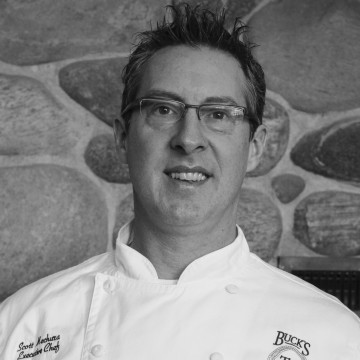
By Scott Mechura EBS FOOD COLUMNIST
From poaching an egg, to skilled knife handling, I believe everyone should have a basic working knowledge and unintimidated view of one of the most-used rooms in their house.
In this first installation of a two-part series, I’ll go over some basics that will open up all sorts of refrigerator and oven doors for you whether you just want to expand your horizons or are trying to entertain friends.
Here are some things that us chefs think every non-chef should know.
How to poach an egg. All you need is a small pot, water that is just less than boiling with a couple drops of vinegar, a slotted spoon, and about 5-6 minutes.
Know your steak temperatures. Here are the basics. Blue rare: 115 degrees, cold red center. Rare: 120 degrees, room temp red center. Medium rare: 125 degrees, warm red center. Medium: 130-134 degrees, warm pink center. Medium well: 138-142 degrees, warm to hot barely pink center. Well done: hot center, no pink, enough said.
At least one one-pot meal. Gather your ingredients for paella, pot roast or curry. Follow the recipe and lay them out on the counter in the order they are in the recipe. Add them when its time.
Proper nachos. The key is no ingredients so big that you can’t get at least three of them on one chip. And when you layer, make a middle layer instead of only piling everything on top.
A properly diced onion. Peel it, and cut it in half with the faint green lines that run end to end, not in half crosswise. Lay the half down on its cut surface and make to slice inward with your knife. Now make vertical slices across the onion. Lastly, make horizontal cuts across the onion and you will have a perfect medium dice.
Don’t be afraid of your broiler. Think of it as an upside-down grill. It gets really hot and cooks with dry, indirect heat. Great for asparagus, fish, chicken, and small cuts of meat.
Know at least two classic cocktails. How better to entertain than to offer a guest one of these while they watch you in the kitchen? Martini: 3 oz. gin, splash of quality dry vermouth, stir or shake over ice and garnish with an olive. Manhattan: 3 oz. rye or bourbon, splash of sweet vermouth, stir in ice, garnish with quality cherry. Negroni: 1 oz. dry gin, 1 oz. Campari, 1 oz. sweet vermouth. Stir and pour over rocks and garnish with an orange twist.
Roast a chicken. Pat dry. Rub with oil, salt and pepper and/or seasonings and herbs of choice. Preheat oven to 450 degrees; put in chicken, drop oven temperature to 350 degrees and roast for approximately 90 minutes, or until golden and juice (it’s not blood!) inside thigh runs clear.
Care for the cast iron. One of the great classic pieces of cookware. Nothing sears a rib eye better than a hot skillet. Cast iron takes a bit longer to heat and cool down but is consistent throughout its surface. After use, scrub vigorously, wipe dry as cast iron will rust, and spray with cooking spray or wipe with oil to create an oxygen barrier. If cared for properly, it will outlive you.
Guacamole. It’s simple. The basics are avocado, lime juice, chopped cilantro, diced onion (hey, you know how to do that), garlic and salt. The mistake everyone makes is not enough salt. Think of an avocado as a bad friend. They take, and they take, and they take…
A basic vinaigrette. Vinaigrettes are just as good on a chicken breast or fish as they are on greens. Here’s a basic guideline. One part acid to four parts oil, three to one if you are adding something sweet like honey. Pinch of salt and pepper. A small diced shallot and a couple cloves of garlic, and two to three tablespoons of any flavor you want, such as herbs, spices or fruit.
Next, we’ll delve a little deeper and explore pickling, ethnic principles, simple wine pairings and leftovers.
Scott Mechura has spent a life in the hospitality industry. He is a former certified beer judge and currently the executive chef at Buck’s T-4 Lodge in Big Sky.
A version of this article previously appeared in a June 2018 edition of Explore Big Sky.














